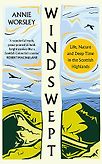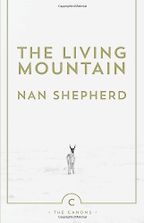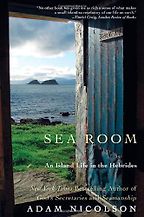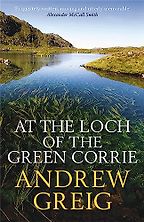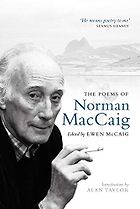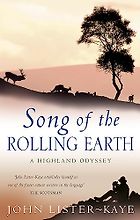Why do the Scottish Highlands inspire so many books?
I think the mixture of dramatic landscape, geology, and that deep sense of history. It’s like a palimpsest—layer upon layer. The more time you spend here in the Highlands, the more you recognise and realise and come to feel yourself part of the different layers of the land. These landscapes are now being recognised as cultural landscapes, rather than ‘wild’ landscapes, which I think is really, really important. Because every inch of the Highlands is part of the cultural heritage of the Highlanders.
Originally people would have come because of the grandeur of the open, wild landscape. A lot of the literature and poetry of the Victorian era was promoting that. Then of course there was the Balmoral-isation of the Highlands—people coming in to buy estates for hunting and shooting. That notion of wilderness still lingers in the minds of a lot of policymakers, to be honest, and possibly in the minds of a lot of people who are still coming to holiday or live here. They see it as wild and untameable, when in actual fact it is very much a human landscape.
So, attitudes are changing. But people still love the Highlands for the drama: the association of mountains and the coast, and now perhaps in other senses as well.
You moved to the northwest Highlands after a career in academia. You now keep a croft, which is a type of Scottish smallholding. How does your background as a physical geographer affect the way you look at the region?
I’ve probably given the game away already. I taught students to look at the geology and geomorphology – glacial landforms, fluvial landforms, and about environmental change and climate change. I think I look at the landscape differently to many people. I’m looking for those subtle colour changes on a hillside which will tell me whether it is a wet flush, or a certain type of soil, or a certain type of geology. Is it an ice melt deposit, is it an ice erosive deposit? Those kinds of features. I’m always looking for the clues in the landscape as to how it was made, why it is the way it is.
“People see the Highlands as wild and untameable, when in actual fact it is very much a human landscape”
My kids always used to say to me, when I was taking them into the mountains: ‘Right, that’s enough, Mum!’ But it’s just innate in me, to want to understand how the landscape is formed, what its characteristics are, and why it is the way it is.
Talking about mountains, let’s look at The Living Mountain by Nan Shepherd. It’s the first book on the Scottish Highlands that you’ve elected to recommend. It’s a very interesting, gentle mountaineering memoir by the Scottish Modernist writer, which has become recognised as something of a modern classic in the years after her death; Robert Macfarlane, who played a key role in its recent flowering, told us it was “a beautifully spare and slender work.” Would you expand?
Yes. It’s an astonishing book. I first came across it by accident, in a tiny bookshop not long after it was first published in the late 1970s.
Right, it was written in the 1940s but sat in a drawer for years.
It’s one of the books that are now regarded to be the finest in nature and landscape writing. It takes you right into the living heart of the Cairngorm Mountains.
It’s a short, slim book, but it gives us more than most major books I’ve read on mountain landscapes and particularly the Cairngorms. It is spiritual, it’s emotional. There’s so much light in it. It dazzled me. And it still does when I re-read it, which I do often.
One of the key aspects is that it transformed the way many modern writers now think of high places. We don’t look at them so much as things that should be conquered with grit and determination and muscle power—mainly male muscle power—but as somewhere where we can learn as much as anything else, about landscape and nature, about ourselves.
She talks of going into the mountain.
That’s right. She uses the most interesting colour descriptors. There’s a section where she talks about the colour blue that reminds me of Rebecca Solnit’s essay on the blue of faraway places. Just thinking about it brings up goosebumps. I think it’s that sense of spiritual acuity, which a lot of writers don’t pick up on or are not able to express. But Nan Shepherd did, and that’s why it’s a book that so many people love.
It gives us a completely different way of looking at mountains, beyond the tourist thinking, ‘goodness, look at that,’ or the mountaineer trying to bag all those Munros, they’ve got to climb this or that face of Ben Nevis with ropes in winter, whatever it is. Here she is, going solo in winter to the top of the Cairngorm plateau and describing the utter bone-flaying beauty of those high places. It’s a wonderful book.
Your second recommendation is The Poems of Norman MacCaig, as edited by his son Ewan. This is a collection of nearly 800 poems. Quite a few are well known—‘Basking Shark,’ for example, has been a set text in Scottish schools for many years. Why is he so good at capturing the spirit of the Highlands and islands?
There’s a great simplicity to his writing. His poems are distinctly about place and people. There are a few that are completely and solely to do with a mountain or river or single wild organism—‘High up on Suilven’:
There are more reasons for hills than being only steep
And reaching only high
He talks of his personal connections with the mountains, but I think it’s not just about the geology, the landforms, the vegetation, it’s about the people and our associations with landscape. His eyes are really sharp. He also has acute observation. It might be two or three words, but it takes you into the heart of that landscape.
For me, one of the poems of his that I love most is ‘Haymaking’ because, of course, that’s what we are doing here on my own croft, using traditional methods. He talks about the Highland Clearances. He doesn’t shy away from those difficult topics. One of his most famous poems is ‘A Man in Assynt,’ in which he asks,
Who owns this landscape? –
The millionaire who bought it or
the poacher staggering downhill in the early morning
with a deer on his back?
Him asking that question reminds me of Robin Wall Kimmerer’s Braiding Sweetgrass, where she asks from an indigenous perspective how we become rooted to place and rooted to land. Norman MacCaig’s poems are rooted to place and to people and to land. Anyone wanting to understand the Highlander and the Highlander’s perspective can’t go wrong in reading this beautiful piece of work.
And you yourself have written, in your memoir Windswept, about the process of becoming rooted to the place too.
We’re in a crofting township called South Erradale. We moved here in 2013 after a lifetime of coming to the Highlands to climb mountains. My husband and I spent a lot of time here before we were married, came on our honeymoon, brought our four kids here on holiday year after year after year. I became disillusioned completely with academic life, and Rob—a pharmacist—decided he’d had enough, and we came and plunged into life in crofting. We manage the croft for traditional hay. It took quite a while to learn the different ways of crofting. And I started to write a blog, almost as letters to the kids more than anything. They’ve moved away from home. And in the writing of the blog, I realised our lives were changing more dramatically than I thought. Then I became ill for a while, and wasn’t able to climb the mountains with Rob, and I started to look at the things around me in more detail, in greater depth. That relationship with nature changed my perspective on crofting too, and how we look at a landscape. And eventually the blog became a book.
You’ve chosen to recommend another memoir about building a relationship with the Scottish Highlands, Adam Nicolson’s book Sea Room. This is one of my own personal favourites. Would you tell our readers about it?
It was given to me when it was first published in paperback around 2002. It’s about the Shiant Isles, on the eastern edge of the Outer Hebrides. I can see them from my house on a good day. Adam’s father bought the Shiants maybe 80 years ago. When Nicolson was 21, his father gave them to him as a gift. And he began a love affair with these islands. The book is the result of all those years of loving these islands. I didn’t imagine for a moment, when I read the book all those years ago, that I’d end up living opposite them.
The books is filled with the most beautiful and elegant prose. It has geography, geology, history, ecology. It talks about the weather, the sea, his own relationship with the land. It’s beautiful. But I chose it not just because it’s a beautifully written book, but because it gives us a little sliver of the Highlands. The islands are not big, but they are the Highlands encapsulated. The story of the Highlands —the geology, maritime history, Clearances, agricultural history—can be found there. There were many trading routes undertaken by sea, from the Mediterranean around the coasts to Shetland and the far north beyond. The passed up and down through the islands. That makes you look at Scottish history in a slightly different way: the real story might lie in the edges, along those sea routes and coast roads. These edgelands as a kind of heartland. There are a lot of treasures in the island landscapes.
Lovely, thank you. The fourth book on the Scottish Highlands that you’d like to recommend is John Lister Kaye’s Song of the Rolling Earth. Lister Kaye is a conservationist and nature writer of many years. This memoir was a bestseller when it came out in 2003.
Again, it’s another book that gives us the story of the Highlands through a small sliver of it. John has an estate that he bought from the Highland Council. He’s written many books, but Song of the Rolling Earth tells the story of how he bought Aigas, set up a field studies centre, and what it taught him about Scottish history, natural history, geography, archaeology. He tackles aspects of Scottish history like the Highland Clearances, the Jacobite Uprisings, and so forth. But he doesn’t get wrapped up in it. He has careful and beautifully observed descriptions of nature and wildlife and his daily routine—how, as he walked through the estate, he learned more about nature, wildlife, and the more enriching these walks became. It’s a lesson to us all about walking in the same places over and over. This happened to me when I was ill. I could only manage short walks, but they became more intense.
One of the interesting things is that he was talking about rewilding long before ‘rewilding’ ever became a term. This is a word bandied around a lot now, and is controversial in some areas. Lister Kaye talks about the ‘retreeing’ of the riverbanks and the ‘re-treeing’ of a little island that appears after a storm flood in the river. After a few years, it starts to grow birch saplings. In actual fact it’s rewilding, and it shows he’s astute enough and wise enough to present this as something we should all be thinking about. It’s another book that shows how we are all interconnected: wildlife, people, landscape, climate. There are threads and entanglements between the elemental and the human. He’s one of the few writers who can articulate this, and he expresses his love for the Highlands from start to finish.
The final book on the Scottish Highlands that you’ve chosen to recommend is Andrew Greig’s At the Loch of the Green Corrie. It’s about his relationship with Norman MacCaig, the Scottish poet we discussed earlier. Could you tell us more?
In the book he takes his two friends on this search for a loch. Just before Norman MacCaig died, he told Greig he should go and see this loch and do some fishing there. Greig didn’t realise that was the last time he was going to see MacCaig.
So he takes these two pals, two brothers, on a search to find the Loch of the Green Corrie, although it turns out it’s not quite called that. And in doing so he tells us about the landscape he’s walking through, and again, here’s a writer who discusses entanglement and interconnectedness with the weather, with geology, with nature. And he talks with great passion about the losses he sees in it— and at first it quite shocks him, this depopulated landscape, which he explains is ruined by overgrazing, by human clearances. But then he falls back in love with it, and says, no: this is the wild bleak landscape we should all be looking for, this extreme and beautiful human landscape. And he understands what Norman MacCaig was all about.
This brings us full circle, back to Nan Shepherd. Because he says to his pals, Look, you’ve got to read The Living Mountain. Greig too writes about the colour and the texture—of the rock, of the vegetation, of the water. He talks about the colour and texture of the light. That’s one of the most astonishing things about the Highlands: the light we are blessed with up here, even on the wildest, wickedest days.
So yes, this book brings us full circle. It’s a beautiful read, and all about that relationship between people and place. In fact, they are all beautifully accessible books: books that will grab you and lead you by the heart into the living beating heart of the Highlands. Each in their own way tells us a little bit more about the Highlands and the people of the Highlands, too.
Interview by Cal Flyn, Deputy Editor
March 4, 2024. Updated: March 5, 2024
Five Books aims to keep its book recommendations and interviews up to date. If you are the interviewee and would like to update your choice of books (or even just what you say about them) please email us at [email protected]
Five Books interviews are expensive to produce. If you've enjoyed this interview, please support us by donating a small amount.

